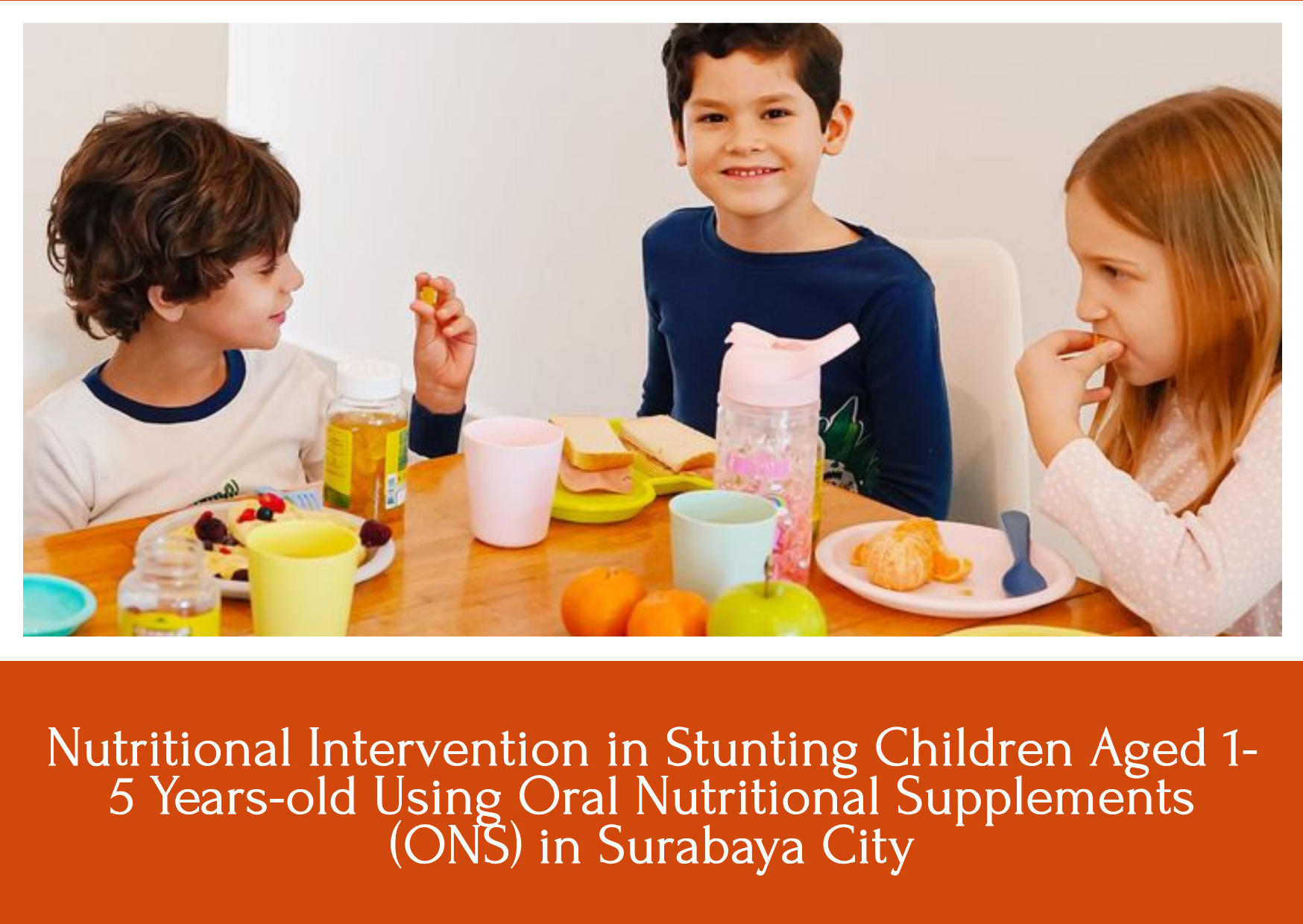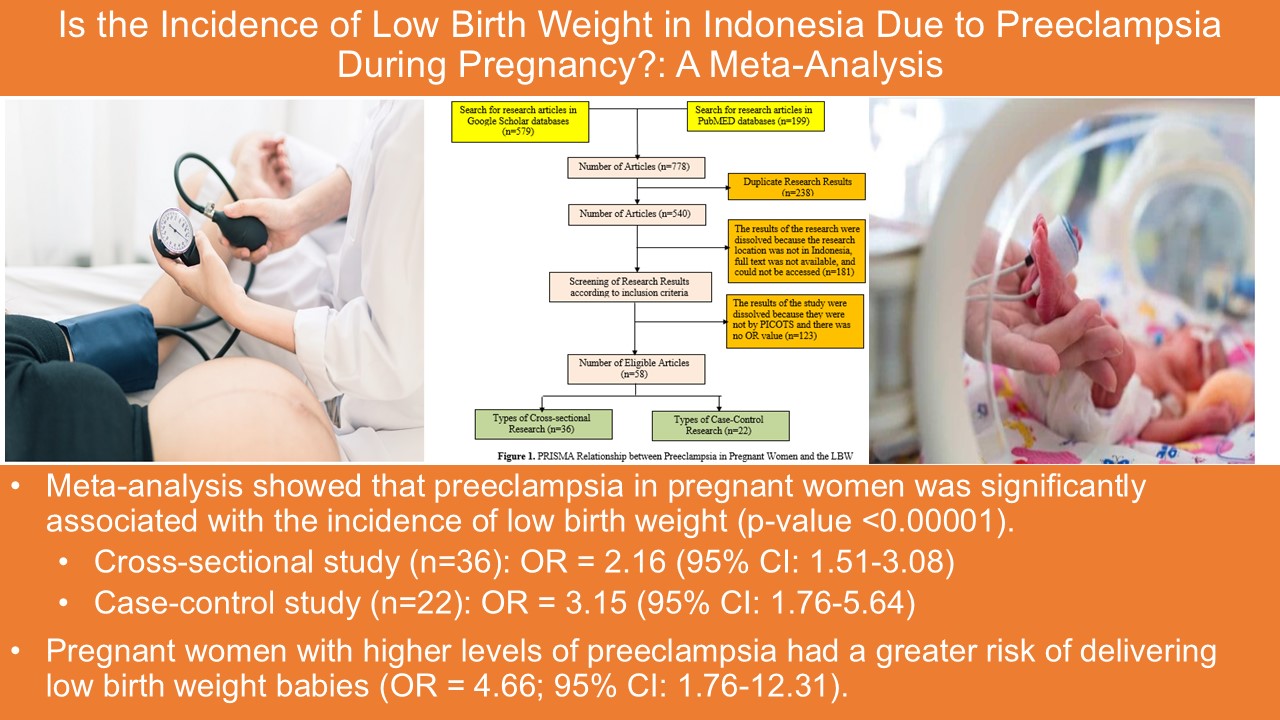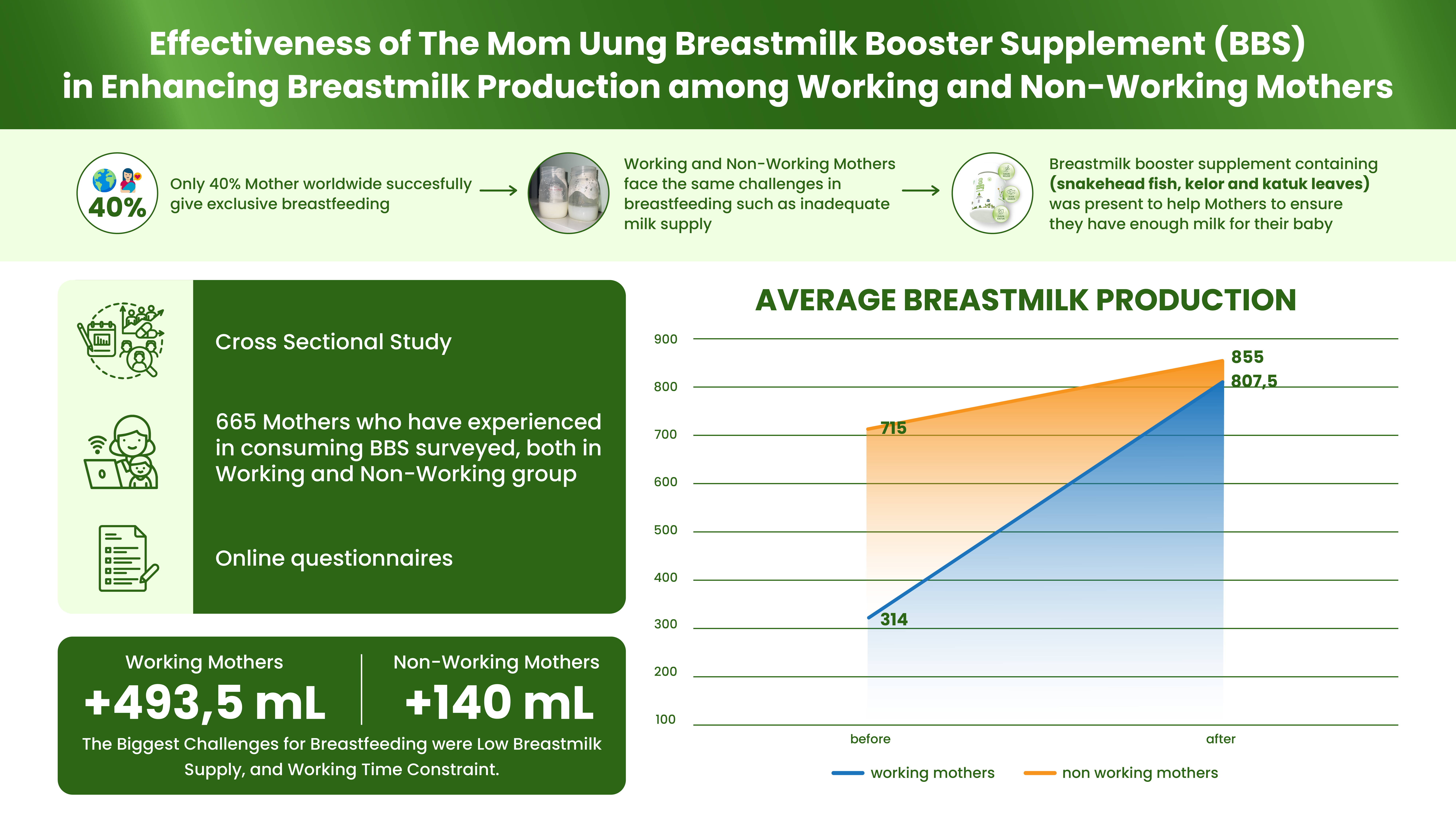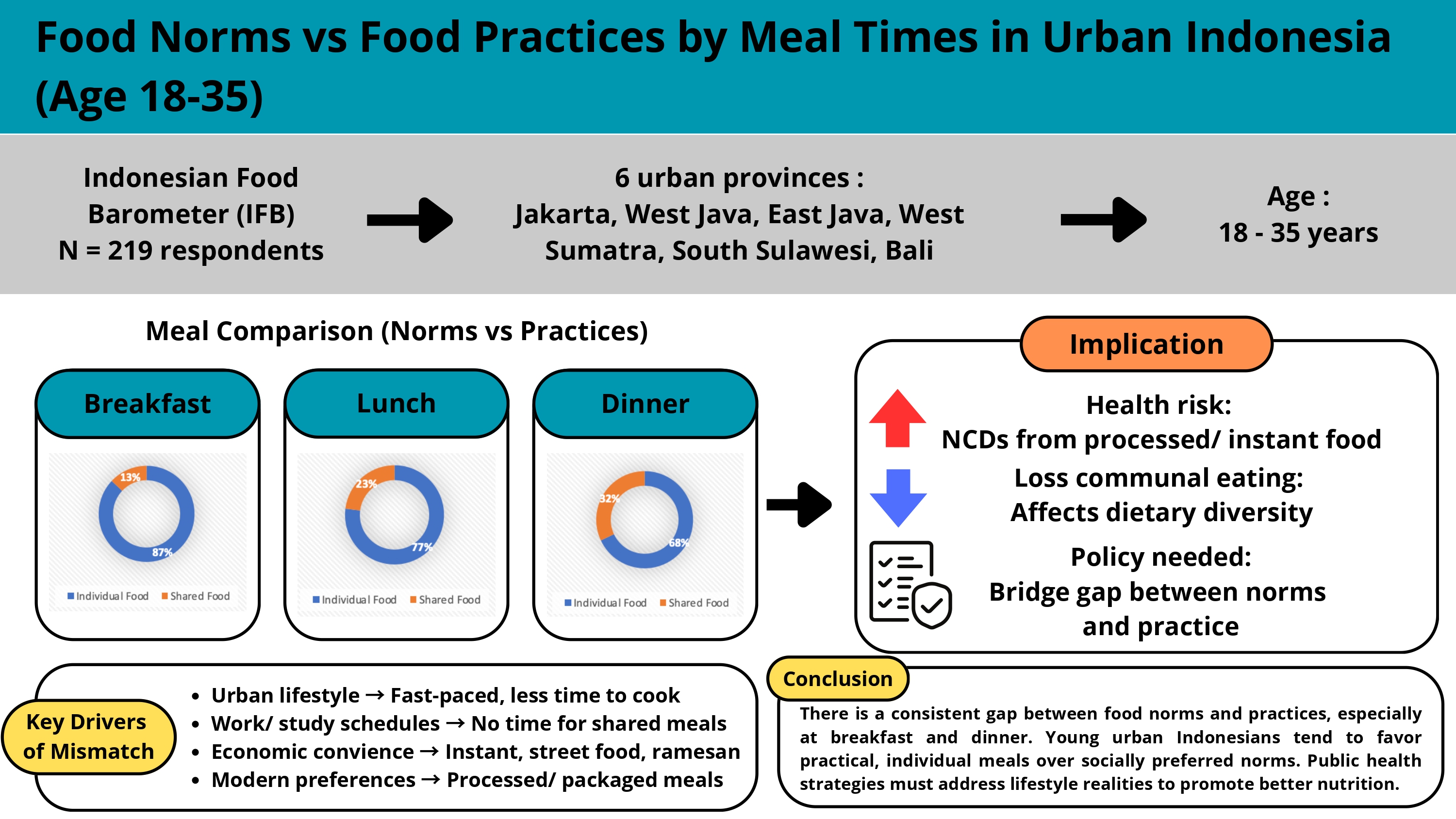NUTRITIONAL INTERVENTION IN STUNTING CHILDREN AGED 1-5 YEARS-OLD USING ORAL NUTRITIONAL SUPPLEMENTS (ONS) IN SURABAYA CITY

Downloads
Growth faltering, also known as failure to thrive, in pediatric populations may arise from a combination of insufficient nutritional intake and the presence of chronic infections. When this condition persists over an extended duration, it can culminate in stunting—a form of chronic malnutrition characterized by impaired linear growth—which continues to exhibit a high prevalence rate across various regions of Indonesia. As part of the national effort to mitigate and prevent stunting, oral nutritional supplements (ONS), which are specifically formulated for both therapeutic and dietary management in pediatric patients with specific health conditions, including growth failure, play a critical role. This study aims to examine the impact of ONS intervention, with a caloric density of approximately 1 kilocalorie per milliliter, on stunted children between the ages of one and five years at a private healthcare facility, namely Husada Utama Hospital in Surabaya. This study is an observational analytical study of a quasi- randomized control trial with a pre- and post-test design. The sample of this study was stunting children aged 1-5 years as many as 20 subjects who were willing to follow the ONS intervention research in achieving optimal growth. After being given intervention for 90 days, the number of normal HAZ/LAZ children became 5 (25% increase). There was a decrease from severely stunting by 7 subjects to stunting and a decrease in stunting to normal by 5 subjects
Ayatollahi, S.M.T., Haem, E., Sharafi, Z., 2015. Growth Velocity of Infants From Birth to 5 Years Born in Maku, Iran. Glob. J. Health Sci. 8, 56–63.
Bhutia, D., 2014. Protein energy malnutrition in India: The plight of our under five children. J. Fam. Med. Prim. Care 3, 63.
Binder, J.-H., Gortsos, C. V., 2015. REGULATION (EU) No 1022/2013 OF THE EUROPEAN PARLIAMENT AND OF THE COUNCIL. Eur. Bank. Union 2012, 115–124.
Bork, K.A., Diallo, A., 2017. Boys are more stunted than girls from early infancy to 3 years of age in rural senegal. J. Nutr. 147, 940–947.
Cliffer, I.R., Masters, W.A., Perumal, N., Naumova, E.N., Zeba, A.N., Garanet, F., Rogers, B.L., 2022. Monthly measurement of child lengths between 6 and 27 months of age in Burkina Faso reveals both chronic and episodic growth faltering. Am. J. Clin. Nutr. 115, 94–104.
de Onis, M., Branca, F., 2016. Childhood stunting: A global perspective. Matern. Child Nutr. 12, 12–26.
DeBoer, M.D., Scharf, R.J., Leite, A.M., Férrer, A., Havt, A., Pinkerton, R., Lima, A.A., Guerrant, R.L., 2017. Systemic inflammation, growth factors, and linear growth in the setting of infection and malnutrition. Nutrition 33, 248–253.
Dewey, K.G., Adu-Afarwuah, S., 2008. Systematic review of the efficacy and effectiveness of complementary feeding interventions in developing countries. Matern. Child Nutr. 4, 24–85.
Faulk, W.P., Demaeyer, E.M., Davies, A.J.S., 1974. Some effects of malnutrition on the immune response in man. Am. J. Clin. Nutr. 27, 638–646.
Hossain, M., Nahar, B., Haque, M.A., Mondal, D., Mahfuz, M., Naila, N.N., Gazi, M.A., Hasan, M.M., Haque, N.M.S., Haque, R., Arndt, M.B., Walson, J.L., Ahmed, T., 2019. Serum Adipokines, Growth Factors, and Cytokines Are Independently Associated with Stunting in Bangladeshi Children. Nutrients 11, 1827.
Isanaka, S., Hitchings, M.D.T., Berthé, F., Briend, A., Grais, R.F., 2019. Linear growth faltering and the role of weight attainment: Prospective analysis of young children recovering from severe wasting in Niger. Matern. Child Nutr. 15, 1–7.
Khadilkar, A., Dhongade, A., Agrawal, N., 2021. Impact of Oral Nutritional Supplement on Growth, Nutrient Intake and Frequency of Illness in Children aged 4-6 Years: A Randomised Controlled Study. J. Clin. Diagnostic Res. 15, 11–16.
Khanna, D., Yalawar, M., Saibaba, P.V., Bhatnagar, S., Ghosh, A., Jog, P., Khadilkar, A.V., Kishore, B., Paruchuri, A.K., Pote, P.D., Mandyam, R.D., Shinde, S., Shah, A., Huynh, D.T.T., 2021. Oral nutritional supplementation improves growth in children at malnutrition risk and with picky eating behaviors. Nutrients 13, 1–15.
Larsen, B.M., 2019. Growth Faltering: The New and the Old. Clin. Pediatr. 2, 1–10.
Maulidiana, A.R., Sutjiati, E., 2021. Low intake of essential amino acids and other risk factors of stunting among under-five children in Malang City, East Java, Indonesia. J. Public health Res. 10, 220–226.
Mckenna, L., Sari, A.H., Mane, S., Scardigli, A., Brigden, G., Rouzier, V., Becerra, M.C., Hesseling, A.C., Amanullah, F., 2022. Pediatric Tuberculosis Research and Development: Progress, Priorities and Funding Opportunities. Pathogens 11, 128.
Menteri Kesehatan Republik Indonesia, 2019. Peraturan Menteri Kesehatan Republik Indonesia No. 29 Tahun 2019 tentang Penanggulangan Masalah Gizi bagi Anak Akibat Penyakit. Jakarta.
Mertens, A., Benjamin-Chung, J., Colford, J.M., Coyle, J., van der Laan, M.J., Hubbard, A.E., Rosete, S., Malenica, I., Hejazi, N., Sofrygin, O., Cai, W., Li, H., Nguyen, A., Pokpongkiat, N.N., Djajadi, S., Seth, A., Jung, E., Chung, E.O., Jilek, W., Subramoney, V., Hafen, R., Häggström, J., Norman, T., Brown, K.H., Christian, P., Arnold, B.F., Abbeddou, S., Adair, L.S., Ahmed, T., Ali, A., Ali, H., Ashorn, P., Bahl, R., Barreto, M.L., Becquey, E., Begín, F., Bessong, P.O., Bhan, M.K., Bhandari, N., Bhargava, S.K., Bhutta, Z.A., Black, R.E., Bodhidatta, L., Carba, D., Checkley, W., Christian, P., Crabtree, J.E., Dewey, K.G., Duggan, C.P., Fall, C.H.D., Faruque, A.S.G., Fawzi, W.W., da Silva Filho, J.Q., Gilman, R.H., Guerrant, R.L., Haque, R., Hasan, S.M.T., Hess, S.Y., Houpt, E.R., Humphrey, J.H., Iqbal, N.T., Jimenez, E.Y., John, J., John, S.M., Kang, G., Kosek, M., Kramer, M.S., Labrique, A., Lee, N.R., Lima, A.Â.M., Mahopo, T.C., Maleta, K., Manandhar, D.S., Manji, K.P., Martorell, R., Mazumder, S., Mduma, E., Mohan, V.R., Moore, S.E., Ntozini, R., Nyathi, M.E., Olortegui, M.P., Ouédraogo, C.T., Petri, W.A., Premkumar, P.S., Prentice, A.M., Rahman, N., Ramirez-Zea, M., Sachdev, H.S., Sadiq, K., Sarkar, R., Sarmin, M., Saville, N.M., Shaikh, S., Shrestha, B.P., Shrestha, S.K., Soares, A.M., Sonko, B., Stein, A.D., Svensen, E., Syed, S., Umrani, F., Ward, H.D., West, K.P., Wu, L.S.F., Yang, S., Yori, P.P., 2023. Causes and consequences of child growth faltering in low-resource settings. Nature 621, 568.
Migang, Y.W., 2021. Pembinaan Deteksi dan Intervensi Dini Tumbuh Kembang Balita pada Kader Posyandu. Randang Tana J. Pengabdi. Kpd. Masy. 4, 60–66.
Pham, D.T., Ninh, N.T., Hoang, T.N., Pham, C.T.K., Nguyen, L.H., Tran, T.Q., Huynh, D.T.T., 2020. The Effectiveness of Oral Nutritional Supplements Improves the Micronutrient Deficiency of Vietnamese Children with Stunting. Arch. Pharm. Pract. 11, 7–13.
Sederquist, B., Fernandez-Vojvodich, P., Zaman, F., Sävendahl, L., 2014. Impact of inflammatory cytokines on longitudinal bone growth. J. Mol. Endocrinol. 53.
Semba, R.D., Trehan, I., Gonzalez-Freire, M., Kraemer, K., Moaddel, R., Ordiz, M.I., Ferrucci, L., Manary, M.J., 2016. Perspective: The potential role of essential amino acids and the mechanistic target of rapamycin complex 1 (mTORC1) pathway in the pathogenesis of child stunting. Adv. Nutr. 7, 853–865.
Shaheen, V.M., Satoh, M., Richards, H.B., Yoshida, H., Shaw, M., Jennette, J.C., Reeves, W.H., 1999. Immunopathogenesis of environmentally induced lupus in mice. Environ. Health Perspect. 107, 723–727.
Sithamparapillai, K., Samaranayake, D., Wickramasinghe, V.P., 2022. Timing and pattern of growth faltering in children up-to 18 months of age and the associated feeding practices in an urban setting of Sri Lanka. BMC Pediatr. 22, 1–10.
Soliman, A., De Sanctis, V., Alaaraj, N., Ahmed, S., Alyafei, F., Hamed, N., Soliman, N., 2021. Early and long-term consequences of nutritional stunting: From childhood to adulthood. Acta Biomed. 92.
Sousa, G.J.B., Silva, J.C. de O., de Queiroz, T.V., Bravo, L.G., Brito, G.C.B., Pereira, A. de S., Pereira, M.L.D., Dos Santos, L.K.X., 2019. Clinical and epidemiological features of tuberculosis in children and adolescents. Rev. Bras. Enferm. 72, 1271–1278.
Stephensen, C., 1999. Burden of infection on growth failure. J. Nutr. 129, 534S-538S.
Tanner, J., 1992. Growth as a Mesasure of the Nutritional and Hygienic Status of a Population. Horm Res 38, 106–115.
Uauy, R., 2013. Improving linear growth without excess body fat gain in women and children. Food Nutr. Bull. 34, 259–262.
Uí Dhuibhir, P., Collura, N., Walsh, D., 2019. Complete Oral Nutritional Supplements: Dietitian Preferences and Clinical Practice. J. Diet. Suppl. 16, 40–50.
UNICEF/WHO/WORLD BANK, 2021. Levels and trends in child malnutrition UNICEF / WHO / World Bank Group Joint Child Malnutrition Estimates Key findings of the 2021 edition, World Health Organization.
Victora, C.G., De Onis, M., Hallal, P.C., Blössner, M., Shrimpton, R., 2010. Worldwide timing of growth faltering: Revisiting implications for interventions. Pediatrics 125.
WHO and FAO, 2016. JOINT FAO/WHO FOOD STANDARDS PROGRAMME CODEX COMMITTEE ON NUTRITION AND FOODS FOR SPECIAL DIETARY USES, Thirty-eighth Session. Geneva, Switzerland.
Zhang, Z., Li, F., Hannon, B.A., Hustead, D.S., Aw, M.M., Liu, Z., Chuah, K.A., Low, Y.L., Huynh, D.T.T., 2021. Effect of oral nutritional supplementation on growth in children with undernutrition: A systematic review and meta‐analysis. Nutrients 13.

This work is licensed under a Creative Commons Attribution-NonCommercial-ShareAlike 4.0 International License.
- MEDIA GIZI INDONESIA Journal is the copyright owner of all materials published on this website.
- The formal legal provisions for access to digital articles of this electronic journal are subject to the terms of the Creative Commons Attribution-NonCommercial-ShareAlike license (CC BY-NC-SA 4.0), which means that MEDIA GIZI INDONESIA Journal and readers reserve the right to save, transmit media / format, manage in database, maintain, and publish articles as long as it continues to include the name of the Author.
- Printed and published print and electronic manuscripts are open access for educational, research and library purposes. In addition to these objectives, the editorial board shall not be liable for violations of copyright law.


2.png)





















